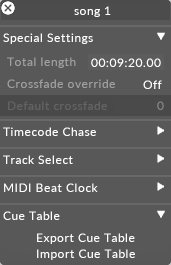The track editor
Right-click the Transport controls title bar. This will open up a Track editor that lets you edit various track properties.

Total Length
This property defines the total length of the track in Hours Minutes Seconds & Frames (HMSF).
Please note: Note that when the Timeline is Quantised, the legacy BPM options return to the dialog.
Crossfade Override
Turns on the crossfade function for this track. For further infomation see the Universal Crossfade section.
Crossfade Duration
When enabled, this controls the crossfade time in beats. For further infomation see the Universal Crossfade section.

If for any reason you need to delay various tracks differently, you can do this by right-clicking the track titlebar to open up the timecode chase tab and editing the MTC adjust property.
For more information on timecode chasing please see the sub-chapter Triggering cues with timecode.

Track ID
To select tracks based on an external MIDI note event, type in the track ID property in the text field with either a note number or note name (eg. C#1). When Disguise software receives a MIDI note, it will scan all tracks in the current active set-list. If it finds a match, it will trigger the track. For more information on MIDI notes please see the sub-chapter Midi notes.
For step-by-step instructions on how to use the track ID property to change tracks with artnet visit Changing tracks with artnet from the sub-chapter Controlling the Timeline with Artnet.

Clock Divider
This property is used when synchronising to MIDI beatclock (as opposed to using timecode). It sometimes happens that the clock received is a multiple of the track bpm. For example, the track may originally be 60 bpm, but the input clock is received at 120 bpm. Setting the clock divider property allows you to scale the input clock; in this example, setting the divider to 2 will achieve the desired result.
Count In
The count in property is also used only when synchronising to MIDI beatclock. When the clock starts for the first time, d3 will wait for the specified number of beats before triggering track play.
Scroll down to the section MIDI beat-clock track settings in the MIDI beat-clock topic for more information.

Disguise softwareallows you to export Track Cue notes to a table, allowing you to edit them en masse in a word processor or spreadsheet.
Export Cue Table
Left-clicking export cue table opens up a tab separated text file in a folder called objects/table.
Import Cue Table
Edit the cue names in the text file. Then go back to the Cue Table and left-click import cue table to load and apply the cue names.